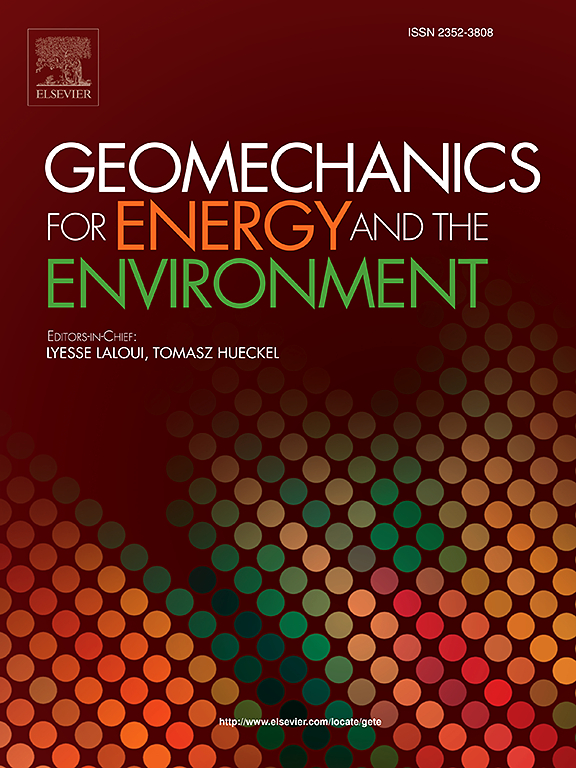具有皮摩软化硬化特性的能源桩热力学分析方法
IF 3.7
2区 工程技术
Q3 ENERGY & FUELS
引用次数: 0
摘要
人们提出了各种方法来分析单个能量桩的热力学行为。虽然这些方法可以解释桩-土相互作用,但缺乏连续描述单个能量桩在热力载荷作用下的荷载传递曲线的全部非线性范围的方法,包括皮摩擦软化和硬化行为。因此,本研究提出了考虑皮摩软化和硬化行为的单个能源桩分析方法。通过将模拟结果与三次有充分记录的现场试验以及实验室和离心机模型试验的结果进行比较,验证了所制定的方法。模拟结果表明,模拟结果与现场测量结果的最大误差百分比为8.8 %,远小于其他方法的误差百分比,表明模拟结果与实际情况的一致性较高。研究结果表明,该方法可以捕捉到荷载传递曲线的全部非线性范围,以及热力学作用引起的应力和位移的本质方面。最后,通过参数分析研究了模型参数对能量桩热力学性能的影响。结果表明:增大无量纲参数对桩的轴向热应力和位移产生相反的影响;增加残余比增大轴向热应力,减小位移和应力,使中性点向桩顶移动。本文章由计算机程序翻译,如有差异,请以英文原文为准。
Thermomechanical analysis method for energy piles with skin friction softening and hardening behavior
Various approaches have been proposed to analyze the thermomechanical behavior of individual energy piles. Although these approaches can account for pile-soil interactions, there is a lack of approaches for continuously describing the full nonlinear range of the load-transfer curve for individual energy piles under thermomechanical loading, including both skin friction softening and the hardening behavior. Therefore, this study developed an analysis method for individual energy piles by considering skin friction softening and hardening behaviors. The developed approach was verified by comparing the simulation results with those of three well-documented field tests, alongside laboratory and centrifuge model tests. The simulation results show a maximum percentage error between the simulation results and the field measurement results is 8.8 %, which is much smaller than that of other methods, indicating a relatively high degree of consistency between the simulation and the actual situation. Besides,the results suggest that the proposed method can capture the full nonlinear range of the load-transfer curve and essential aspects of the pile in terms of the stress and displacement induced by the thermomechanical operation. Finally, a parametric analysis was conducted to study the effects of the model parameters on the energy pile thermomechanical performance. Results show that increasing the dimensionless parameter changes the pile axial thermal stress and displacement oppositely; increasing the residual ratio boosts axial thermal stress, reduces displacements and stress, and moves the neutral point (NP) towards the pile head.
求助全文
通过发布文献求助,成功后即可免费获取论文全文。
去求助
来源期刊

Geomechanics for Energy and the Environment
Earth and Planetary Sciences-Geotechnical Engineering and Engineering Geology
CiteScore
5.90
自引率
11.80%
发文量
87
期刊介绍:
The aim of the Journal is to publish research results of the highest quality and of lasting importance on the subject of geomechanics, with the focus on applications to geological energy production and storage, and the interaction of soils and rocks with the natural and engineered environment. Special attention is given to concepts and developments of new energy geotechnologies that comprise intrinsic mechanisms protecting the environment against a potential engineering induced damage, hence warranting sustainable usage of energy resources.
The scope of the journal is broad, including fundamental concepts in geomechanics and mechanics of porous media, the experiments and analysis of novel phenomena and applications. Of special interest are issues resulting from coupling of particular physics, chemistry and biology of external forcings, as well as of pore fluid/gas and minerals to the solid mechanics of the medium skeleton and pore fluid mechanics. The multi-scale and inter-scale interactions between the phenomena and the behavior representations are also of particular interest. Contributions to general theoretical approach to these issues, but of potential reference to geomechanics in its context of energy and the environment are also most welcome.
 求助内容:
求助内容: 应助结果提醒方式:
应助结果提醒方式:


